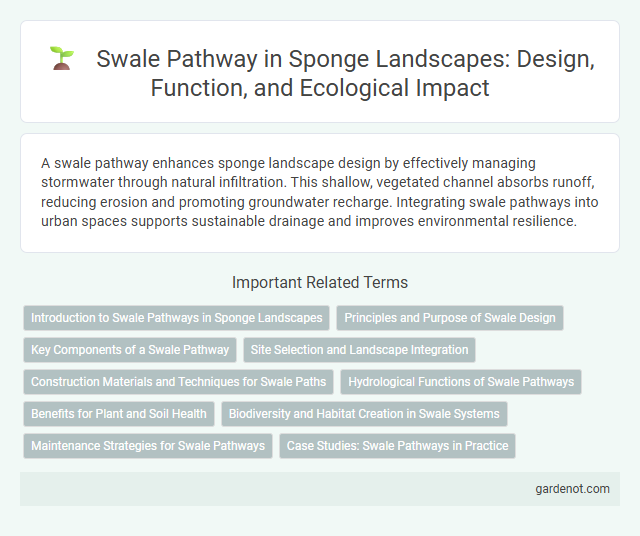A swale pathway enhances sponge landscape design by effectively managing stormwater through natural infiltration. This shallow, vegetated channel absorbs runoff, reducing erosion and promoting groundwater recharge. Integrating swale pathways into urban spaces supports sustainable drainage and improves environmental resilience.
Introduction to Swale Pathways in Sponge Landscapes
Swale pathways are essential components in sponge landscapes designed to enhance water absorption and reduce runoff. These shallow, vegetated channels effectively capture rainwater, directing it into the ground to recharge aquifers and support plant growth. Integrating swale pathways improves urban water management by mitigating flooding and promoting sustainable drainage.
Principles and Purpose of Swale Design
Swale pathways are designed to manage stormwater by promoting infiltration and reducing runoff through shallow, vegetated channels. The principles of swale design emphasize maximizing water capture, slowing flow velocity, and enhancing soil absorption to improve groundwater recharge and minimize erosion. Purpose-built swales also support ecological functions by filtering pollutants and providing habitat within urban landscapes.
Key Components of a Swale Pathway
A swale pathway incorporates key components such as a gently sloped trench designed to direct and absorb stormwater runoff, permeable soil layers that enhance infiltration, and native vegetation that stabilizes the soil while filtering pollutants. These elements work together to reduce surface water flow, prevent erosion, and recharge groundwater. Proper engineering also includes an underdrain system for excess water management and mulch layers that retain moisture and support plant health.
Site Selection and Landscape Integration
Swale pathways should be strategically located in low-lying areas with natural water runoff to maximize stormwater capture and infiltration. Selecting sites adjacent to existing vegetation or natural depressions enhances landscape integration, promotes biodiversity, and stabilizes soil. Incorporating native plants along the swale edges improves habitat connectivity and supports local ecosystems within urban or suburban landscapes.
Construction Materials and Techniques for Swale Paths
Swale pathways are constructed using permeable materials such as gravel, crushed stone, or permeable pavers to facilitate efficient stormwater infiltration and reduce surface runoff. Techniques involve grading the path to create a gentle slope that directs water into adjacent swales, ensuring proper drainage and soil absorption. Incorporating geotextile fabrics beneath the surface materials enhances soil stability and prevents erosion while maintaining water permeability.
Hydrological Functions of Swale Pathways
Swale pathways enhance stormwater management by promoting infiltration and reducing surface runoff through their shallow, vegetated channels designed to capture and slow water flow. These structures facilitate groundwater recharge by allowing water to percolate into the soil, effectively filtering pollutants and preventing urban flooding. Integrating swale pathways within sponge landscapes optimizes hydrological cycles by balancing water retention and drainage, supporting sustainable urban water management.
Benefits for Plant and Soil Health
Swale pathways enhance plant health by improving water infiltration and reducing soil erosion, creating optimal moisture conditions for root growth. They support soil biodiversity by maintaining a balanced microenvironment that fosters beneficial microbial activity and nutrient cycling. The design of swale pathways also prevents nutrient runoff, ensuring sustained soil fertility and healthier vegetation growth.
Biodiversity and Habitat Creation in Swale Systems
Swale pathways enhance biodiversity by providing diverse habitats that support native flora and fauna, promoting ecological balance within urban landscapes. These systems facilitate natural water filtration and create microhabitats for pollinators, amphibians, and birds, increasing local species richness. Implementing swale designs with native vegetation encourages habitat connectivity and improves ecosystem resilience against environmental stressors.
Maintenance Strategies for Swale Pathways
Effective maintenance strategies for swale pathways include regular inspection and removal of sediment, debris, and invasive vegetation to ensure proper water infiltration and flow. Periodic regrading and soil compaction assessment help maintain the swale's structural integrity and prevent erosion. Incorporating native plants promotes robust root systems that enhance filtration and reduce maintenance frequency.
Case Studies: Swale Pathways in Practice
Swale pathways effectively manage stormwater by channeling runoff through vegetated depressions that promote infiltration and reduce surface flow. Case studies demonstrate significant improvements in urban flood mitigation and water quality enhancement in cities such as Portland and Melbourne, where swale systems have been integrated into public parks and residential developments. Data reports indicate up to 70% reduction in peak stormwater discharge and substantial decreases in pollutant loads through these landscape interventions.
Swale pathway Infographic

 gardenot.com
gardenot.com